BAROQUE, ROCOCO, ROMATICISM, NEOCLASSICISM
1/104
There's no tags or description
Looks like no tags are added yet.
Name | Mastery | Learn | Test | Matching | Spaced |
|---|
No study sessions yet.
105 Terms
Baroco
portuguese term for imperfect pearl
BAROQUE
Artists placed emphasis on emotion and dynamism and there was a deliberate lack of clarity when it comes to themes.
is a highly ornate and elaborate style of architecture, art and design that flourished in Europe in the 17th and first half of the 18th century.
it became the first visual style to have a significant worldwide impact.
Large domes or cupolas
elaborate motifs and decorations
gilded sculpture on the interior and exterior
attention grabbing features
double sloped mansard roof
contrast between light and dark
CHARACTERISTICS OF BAROQUE ARCHITECTURE
Large domes or cupolas
These were generally positioned at the center of a building. Windows were built into domes and illuminated to highlight the architectural features.
Elaborate motifs and decorations
Details are very intricate, adding to the extravagance and sacredness of the space. Motifs included human, animal, and floral forms, often combined and featuring scrolls and garlands.
Gilded sculpture on the interior and exterior
Statues were made from plaster or marble and included highly contrasting colors and textures.
Attention-grabbing features
Features included curved walls, frescoes, columns, sculptures, arches, niches, fountains, scrolling, and broken pediments. Highly detailed vaulted ceilings were often painted like the sky to make rooms seem open to the heavens.
Double-sloped mansard roof
The mansard roof (a hip roof with two slopes) is a key element of French Baroque architecture and is incorporated in many châteaux or country mansions.
Contrast between light and dark
Building elements were designed to show a high contrast of light and shadow to create extreme drama. In drawing and painting, this treatment of light and shade is called chiaroscuro. Baroque painters included Caravaggio, Rembrandt, Peter Paul Rubens, Bernini, and Velazquez.
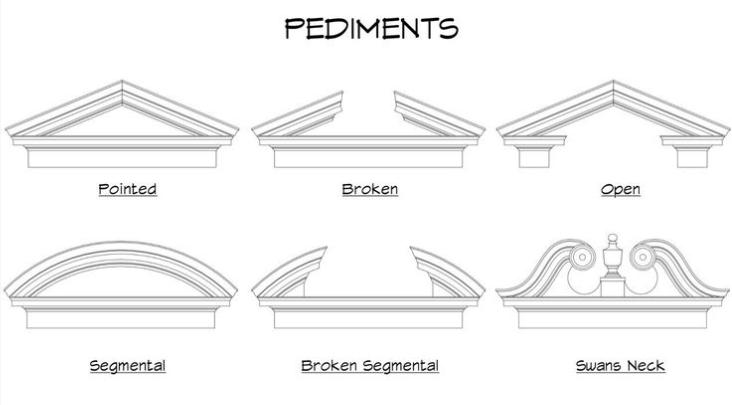
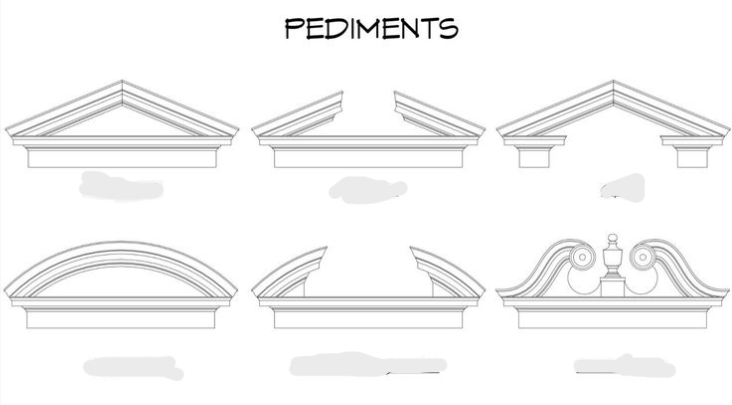
Caravaggio, Gentileschi, and Bernini
created the styles of the Baroque period with an added emphasis on emotional art.
Michelangelo Merisi da Caravaggio (1571-1610)
One of the most persuasive contributors to Baroque art was him who was born in Milan, Italy.
illuminated lighting
the stark contrast between the light and dark areas to produce dramatic religious scenes where the human form emerged out of a deep shadow.
Tenebrism
with its powerful distinctions of light and dark, became the painting process used for Baroque in Italy.
Also called the 3rd lighting technique, comes from the word tenebroso meaning to obscure. It is the use of a very dark overall tonality of the painting.
St. Peter's Basilica by Bernini
Façade was made by Carlo Maderna while the baldacchino and piazza by Bernini. The Piazza was surrounded by 284 columns in the Tuscan Style. The basilica was also topped with various popes.
Baldacchino over the tomb of St. Peter by Bernini
a towering bronze canopy sculpted over the High Altar of St. Peter's Basilica in Rome.
San Carlo Alle Quattro Fontane by Francesco Borromini
Established Borromini's reputation because it featured an alternation of concave and convex elements in the façade.
Fountain of Trevi
As the largest fountain in Rome, and arguably one of the most exquisite Baroque structures worldwide, the Trevi Fountain is more than just an attraction; it's a symbol of Rome's rich artistic heritage. The fountain's design, a harmonious blend of sculptures and water, showcases the pinnacle of Baroque aesthetics.
FRENCH BAROQUE
developed during the 17th and 18th centuries, with the most significant pieces built in the late 17th century during the reign of Louis XIV and the royal architects Louis Le Vau and Jules Mansart.
FRENCH BAROQUE
we find that this was a secular architecture, focused not on religious imagery but ON PALACES.
FRENCH BAROQUE
Buildings were designed to show power, so they were very magnificent and opulent. Architectonic layout continues to be symmetric, classical orders are widely used, and curved lines add a sense of motion to the structures.
Although exteriors were sober, the interiors were highly ornamented, with plenty of sculptures, paintings, tapestries, and ornaments such as moldings, wood carvings, and brass applications.
Palace of Versailles
a magnificent example of French Baroque architecture, is the most famous royal chateau in France. The gigantic scale of this exemplifies the architectural theme of 'creation by division' - a series of simple repetitions rhythmically marked off by the repetition of the large windows - which expresses the fundamental values of Baroque art and in which the focal point of the interior, as well as of the entire building, is the king's bed.
Louvre Palace in Paris
In the early 17th century Jacques Lemercier added the French Baroque style to the Louvre while expanding one of the wings and adding a central pavilion. In 1659 Louis Le Vau joined the list of architects who had an influence on the property.
Catholic Church of the Val-de-Grâce
A rare Parisian building in the Baroque style, this church was built by François Mansart on the orders of Queen Anne of Austria for the birth of Louis XIV.
ENGLISH BAROQUE
started in the late 15th century in England and ended in the mid 16th century. St. Paul's Cathedral is known for this style as the building is home to the first dome to be constructed in Britain.
ENGLISH BAROQUE
The main element of this style was the use of domes. The window sizes in the buildings are increased and classical elements are used. A style with some similar elements such as columns and porticoes is the Neoclassical style. The style has lots of curves and often features classical figures in rounded alcoves
St.Paul's Cathedral
Designed by the famous Sir Christopher Wren, it's an example of the English baroque style. It has massive dome, one of the largest in the world, sitting proudly at 365 feet high. The intricate design inside, with beautiful Mosaics, carved stone, and elegant ironwork.
Blenheim Palace
is regarded as one of the finest examples of English Baroque architecture. It was a gift to the Duke from a grateful Crown and nation to commemorate his victory in 1704 over the French and Bavarians at Blenheim (now Blindheim) during the War of the Spanish Succession (1701–1714).
Castle Howard by Sir John Vanbrugh
This stunning Baroque mansion has been the residence of the Howard family for over 300 years. This is a magnificent building, a fusion of classical and Renaissance elements that has been designed to impress and inspire visitors from around the world
Designed by the famous architect Sir John Vanbrugh, who was known for his flamboyant baroque style. The building was commissioned by the 3rd Earl of Carlisle and construction began in 1699.
Solomonic Columns
Named ______ because it was believed to be derived from Solomon's temple. These are columns with a twisted shaft.
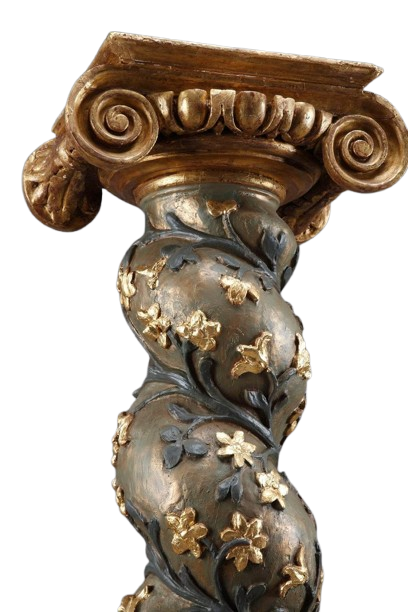
Santa Maria della Salute by Baldassare Longhena
Roman Catholic Church which had a lot of sculptural figures. It was made round to symbolize the womb of Mary.
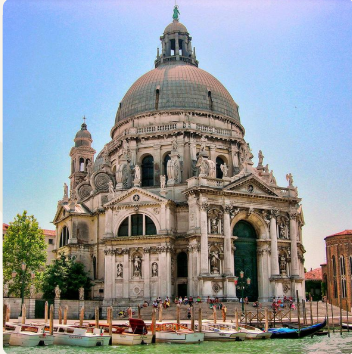
Church of Il Gesu by Giacomo Vignola
The mother church of the Society of Jesus or the Jesuits. The façade is considered the first truly baroque façade.
Gauli's Ceiling Fresco by Giovanni Battista
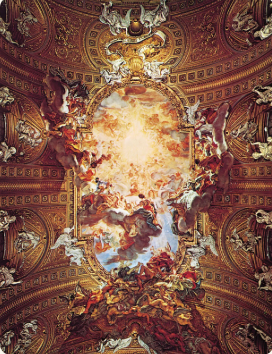
Quadratura
An illusion of figures trying to crawl out from the painting space; portions of architecture blending with painting featuring a lot of gilding in Baroque.
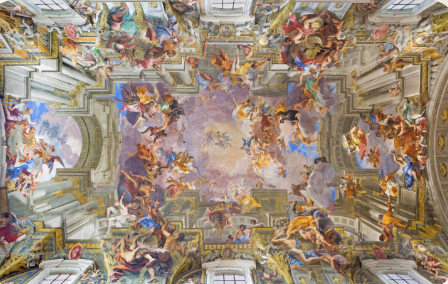
Michelangelo Caravaggio
He used dramatic, realistic and chiaroscuro technique. He chose ordinary people as the figures in his religious works. Created Tenebrism.
Tenebrism
Also called the 3rd lighting technique, comes from the word tenebroso meaning to obscure. It is the use of a very dark overall tonality of the painting.
Rembrandt van Rijn
Greatest genius of the Dutch school who painted portraits and scenes of genre and
religious subjects.
Created Rembrandt lighting (A type of low-key lighting technique that shows graded transitions from light to dark with shadows in warm colors. Features a warm white
drama.)
Jan Vermeer
Little Dutch Master.
His usual subjects focus on women doing household chores.
Peter Paul Rubens
Greatest Flemish painter of Baroque. He was able to produce about 2000 paintings.
Rubenesque - Means voluptuous and muscular figures as the beauty ideal.
Imprimatura - The combination of light effects and color also known as chromatic intensity.
Anthony Van Dyck
He specialized in aristocratic portraiture that featured exquisite detailing of silken fabrics, fine laces and trimmings.
Gianlorenzo Bernini
Mainly a sculptor, he was influenced by Michelangelo and used dynamism to portray figures.
Rococo
derived from the French word rocaille, which denoted the shell-covered rock work that was used to decorate artificial grottoes.
rococo
It is characterized by lightness, elegance, and an exuberant use of curving natural forms in ornamentation. It was perhaps the most rebellious of design styles. Often described as the final expression of the Baroque movement, it was exceptionally ornamental and theatrical – a style without rules.
Rococo
a style developed by craftspeople and designers rather than architects. This explains why it is found primarily in furniture, silver, and ceramics.
French rococo
a highly ornate architecture, art, and interior design. It is characterized by its use of light colors, intricate designs, and elaborate furniture.
A palette of pastel colors.
Serpentine, or S-curved, patterns.
Asymmetrical design.
gold and gilded ornaments
Naturalistic motifs, such as flowers, vines, rocks, pebbles, and seashells in ornamentation.
Furniture made from mahogany, beech, oak, and walnut.
CHARACTERICS OF FRENCH ROCOCO
Jean-Antoine Watteau
is regarded as the first Rococo artist (or the father of the movement), and was known for popularizing the fête galante style. He sensuously painted Rococo canvases conveyed courtly love and ideas of reverie, longing, and utopia.
JUSTE-AURÈLE MEISSONNIER
was a French goldsmith, interior decorator, and architect, often considered the leading originator of the influential Rococo style in the decorative arts.He had a powerful and fertile imagination; his fantastic grottoes and swirling, animated, asymmetrical metalwork designs combined contrasting and original motifs.
GERMAIN BOFFRAND
was a French architect and interior decorator whose mastery of the new Louis XV or rococo style widely influenced 18th-century architecture in France and abroad. He codified and disseminated the supple rococo style which borrowed, in miniature scale, more from the Italian baroque of Francesco Borromini and Guarino Guarini than from the stringent academic classicism favored in France since the Renaissance.
JEAN-MICHEL CHEVALET
was a French architect. He and Pierre Contant d'Ivry were among the most eminent Parisian architects of the day and designed in both the restrained French Rococo manner, known as the "Louis XV style" and in the "Goût grec" (literally "Greek taste") phase of early Neoclassicism.
FAUTEUILS
This French armchair, called a "fauteuil à la reine" for its upright back and "à chassis" for its easily removable upholstery, exemplifies the transition between Rococo and Neoclassical styles.
Made by Parisian furniture maker Louis Delanois (1731–1792)
the chair retains Rococo features like cabriole legs and curved, set-back arm supports.
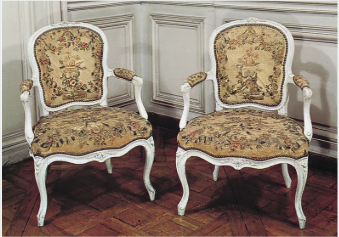
BERGERE CHAIRS
a distinctive piece of furniture that exudes elegance and sophistication. Originating in France during the 18th century, these chairs are characterised by their upholstered frames, exposed wooden elements and generous cushioning.
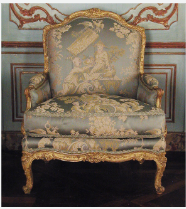
VOYEUSE CHAIRS
It is a chair of the 18th century used at game tables, having a padded top rail on which spectators could lean.
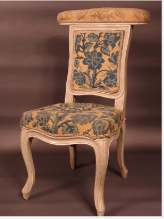
COMMODES
This elegant Louis XV-style is an exceptional example of 18th-century-inspired craftsmanship. Constructed from fine wood, likely mahogany, it features a luxurious white marble top that complements its rich, warm tones. The piece is adorned with six spacious drawers and two lockable cabinets, offering both practicality and beauty. The shape of this commode, with its serpentine outline, two drawers, and shaped apron resting on tall cabriole legs, became the standard form of the Rococo _______.
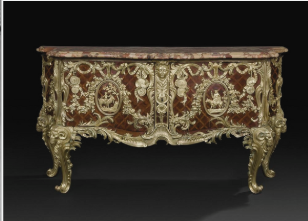
Lit à la Polonaise polish bed
By the mid-18th century a new bed style was introduced, named after Louis XV’s Polish queen. alternatively known in English as a polonaise, is a type of small-canopy bed which most likely originated in Poland and became a centrepiece of 18th-century French furniture. The curtain is topped with an elaborate crownlike centrepiece, which is connected to the four vertical corner poles of the bed frame (which are usually curved). Unlike the four-poster bed, the canopy is much smaller than the bed.
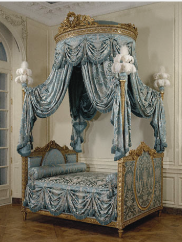
Hôtel de Soubise in Paris
was created in the early 1700’s for the Prince and Princess de Soubise (Anne de Rohan-Chabot, a former mistress of Louis XIV). One of its most splendid rooms is the Salon de la Princesse, above, an oval chamber embellished in finest Rococo fashion with intricate, gilded boiserie (carved wood), cherubs, ceiling paintings and mirrors. They are designed by Germain Boffrand and Charles-Joseph Natoire (1735 – 1740)
Palace of Versailles
Many parts of this building demonstrate Rococo, including the dramatic statues at the garden’s fountains and the rich decorations in its salons. Other royal buildings, such as the Branicki Palace in Poland and the Catherine Palace in St. Petersburg also evoke Rococo style.
Château de Chantilly
It is a historic French château located in the town of Chantilly, Oise, about 50 kilometres (30 miles) north of Paris. The château's art gallery, the Musée Condé, houses one of France's finest collections of paintings. With its décor of white and gold panels, it is typical of the early Rococo style.
Boiserie
is a highly-skilled art form in which wood paneling is carved in painstaking detail
and then gilded or painted.
Rocaille
one of the more prominent aspects of the Rococo style of architecture and decoration that developed in France during the reign of King Louis XV (1715–74). It features elaborately stylized shell-like,rocklike, and scroll motifs. It has been defined as a reaction both to the classic rigidity of the waning Baroque style and to the new interest in nature and the natural sciences. In French, the word means “rubble,” of “pebbles,” and this style is synonymous with Rococo.
Cartouches
are characterised by elaborate curved and floral ornamentation, gilding, white and pastel colours, stylised shapes inspired by nature (vegetables, shell and rock motifs were popular), animals and Chinese and Japanese motifs.
Ormolu
or “gilding with gold paste”, is a gold-coloured alloy of copper, zinc, and sometimes tin, in various proportions but usually containing.
CHINOISERIE
used mainly in conjunction with Baroque and Rococo styles, featured extensive gilding and lacquering; much use of blue-and-white (e.g., Delftware); asymmetrical forms; disruptions of orthodox perspective; and Oriental figures and motifs.
ENGLISH ROCOCO
a highly ornate and decorative style of art that emerged in France during the early 18th century and spread to other parts of Europe – including England. Often referred to as Late Baroque, Its is characterized by its opulent decoration and nature-themed designs.
mainly influenced furniture, silver and ceramics.
naturalism
short curves, scrolls and counter curves, often elaborated with fantasy.
Characteristics of ENGLISH ROCOCO
Thomas Chippendale
He was one of the leading cabinetmakers of 18th-century England and one of the most perplexing figures in the history of furniture. His name is synonymous with the Anglicized Rococo style.
Thomas Gainsborough
He was the only important English portrait painter to devote much time to landscape drawing. He composed a great many drawings in a variety of mediums including chalk, pen and wash, and watercolour, some of them varnished. He was intimately involved with avant-garde rococo art and design, and seems to have assisted Francis Hayman on his genre paintings for the decoration of Vauxhall Gardens.
CHIPPENDALE STYLE FURNITURES
This incorporated pointed arches and ogee (S-shaped) curves into the backs of chairs and, more successfully, in the glazing bars (wooden tracery holding the glass) and pediments of massive bookcases.
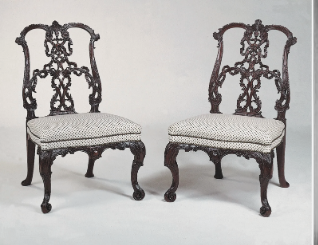
Chippendale
The term specifically refers to English furniture of the 1750s and ’60s made in a modified Rococo style.
Royal Pavilion in Brighton
It was designed for the Prince Regent, later King George IV (1762-1830) in the early 19th century in the Picturesque style by the nationally significant and influential architect and landscape designer John Nash (1752-1835), with planting by the royal gardener William Aiton (1766-1849).
ITALIAN ROCOCO
a movement in art that began in the late 17th century and reached its
height in the 18th century. The style is characterized by ornate, highly detailed designs with a light, airy feel. Rococo artists often used pastel colors and incorporated elements of nature into their work.
Curvilinear forms
Delicate ornamentation
Playful themes and allegories
Emphasis on sensuality and sensitivity
Naturalism and Realism
Influence on Painters and Artisans
Arabesque style ( featuring intricate and flowing
motifs inspired by nature, such as foliage, scrolls, and
shells.)
CHARACTERISTICS OF ITALIAN ROCOCO
Giovanni Battista Tiepolo
was an influential Italian painter and a leading figure of the Rococo movement.
Renowned for his vibrant frescoes and dramatic compositions, his works showcased mythological, historical, and religious subjects with theatrical flair.
Marcello Bacciarelli
was an Italian Rococo and Neoclassical painter renowned for his portraits and historical scenes.
His portraits, such as “Portrait of Stanisław August Poniatowski,” reveal his ability to capture the personality and essence of his subjects with remarkable detail.
Jacopo Amigoni
was a prominent Rococo artist whose paintings exemplify the luxurious and ornate nature of the style.
His compositions often included figures dressed in opulent attire, set against lavish backgrounds filled with decorative elements.
His works, like “The Drawing Lesson,” reflect the Rococo fascination with aristocratic life and the pursuit of pleasure.
Venetian furnitures
was well known for being rich and luxurious, with usually very extravagant designs. Unique type of this furniture, such as the divani da portego, or long Rococo couches and pozzetti, objects meant to be placed against the wall.
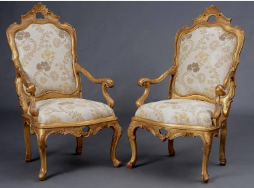
Sicilian furniture
tended to be highly unusual, and even though was based on the principles of French Rococo designs, usually included some traditional elements in this style. Commodes and console tables had cabriole legs, which were, however, plain, and usually had intricate scrollwork and arabesques.
GENOESE FURNITURES
was ALSO highly unusual in style. These were famous for making grand beds and chairs. ____ armchairs were similar to the French fauteuils, but often had a wider, more exaggerated backs, gilded wood, and included intensely rich fabrics, such as silk and velvet.
Piedtmontese Furnitures
The Kingdom of Sardinia's greatest son in the field of Rococo interior designing was without a doubt Pietro Piffetti (1700–1770), who made Sardinian Rococo style so refined and elegant.
His famous designs emerged as being Sardinian/Piedmontese and were famous for their highly intricate designs, exotic materials, flamboyant cartouches and the unique tortoiseshells, which became popular under Rococo zenith.
Ca' Rezzonico
It is a palazzo and art museum on the Grand Canal in the Dorsoduro sestiere of Venice, Italy.
It is a particularly notable example of the 18th century Venetian baroque and rococo architecture and interior decoration, and displays paintings by the leading Venetian painters of the period, including Francesco Guardi and Giambattista Tiepolo.
Palazzina di Caccia di Stupinigi
This Palace's Great Hall is the best example of Italian Rococo. Built from 1729 to 1733, architect Filippo Juvara used painted entablatures and coffers to create a sense of play.
It is highly ornate, and mostly white with gilded decoration and inset paintings.
Palazzo Pianetti
or Pianetti Tesei is a Rococo palace in the town of Jesi, Italy. Presently, it is owned by the town, and the palace and its adjacent building are used as a museum and exhibition site.
Stucco
A particularly distinctive trait of Rococo architecture is seen in the use of this. This was a decorative coating in the form of a paste, which hardened when it was applied to a surface.
used to create relief-like textures on furniture, ceilings, and walls.
THE VEILED CHRIST
is a masterpiece sculpted by Italian Rococo sculptor Giuseppe Sanmartino in the 18th century. It depicts the body of Christ covered with a transparent veil sculpted so realistically that it appears like actual fabric.
MODESTY
is a captivating sculpture created by Antonio Corradini, an Italian sculptor of the 18th century. The veiled effect achieved by Corradini is remarkable, as the translucent material seems to reveal the contours of the woman’s body beneath, while still maintaining an aura of mystery and modesty.
The Veiled Woman
by Italian sculptor Antonio Corradini often associated with the Vestal Virgin Tuccia, captures a moment of serene beauty and mystique.
symbolizing the sacred role of the Vestal Virgins in ancient Roman society.
Juno and Luna
painted by Giovanni Battista Tiepolo, featuring the Roman goddesses Juno and Luna.
Juno, the queen of the gods, and Luna, the goddess of the moon, are depicted in a celestial setting, likely emphasizing their divine beauty and power.
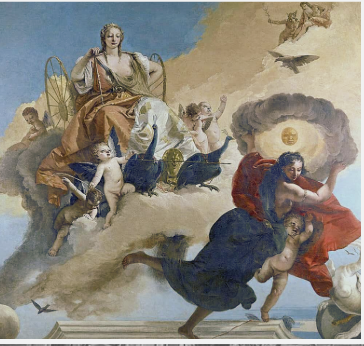
Romanticism
characterized many works of literature, painting, music, architecture, criticism, and historiography in Western civilization over a period from the late 18th to the mid-19th century.
prioritises emotion and individualism while drawing inspiration from nature and the medieval period.
Characterised by its intricate designs, dramatic contrasts, and use of materials like stone and wood, it often evokes a sense of nostalgia and imagination.
Common architectural elements in Romantic buildings included asymmetrical designs, disproportionately weighted towers with parapets, spires, and gables topped with finials or crossbracing.
Romanticism characteristics
CASPAR DAVID FRIEDRICH
He was a German Romantic landscape painter, generally considered the most important German artist of his generation, whose often symbolic, and anti-classical work, conveys a subjective, emotional response to the natural world.
His paintings often set contemplative human figures silhouetted against night skies, morning mists, barren trees or Gothic ruins.
Francisco Goya
He was a Spanish romantic painter and printmaker.
He is considered the most important Spanish artist of the late 18th and early 19th centuries.
is often referred to as the last of the Old Masters and the first of the moderns.
J.M.W Turner
was an English Romantic landscape painter known as 'the painter of light'
because of his increasing interest in brilliant colours as the main constituent in his landscapes and seascapes.
Canopy beds
These beds with curtains that could completely enclose the bed were used by lords and noblemen in medieval Europe for warmth and privacy.
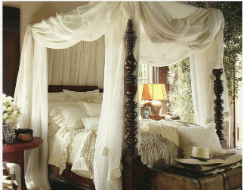
Chinoiserie furnitures
can be noted for lacquered finish and use of pagoda and dragon motifs. Delicate and light, this was associated with the bedrooms and dressing rooms of ladies.

Palace of Westminster
is the meeting place of the Parliament of the United Kingdom and is located in London, England. It is commonly called the Houses of Parliament after the House of Commons and the House of Lords, the two legislative chambers which occupy the building.
is an excellent example of the Romantic style of Architecture with its turrets, steeped pitched roofline, and asymmetrical towers.
Neuschwanstein Castle in Germany
is known as a castle of paradox. It was built in a time when castles were no longer necessary as strongholds, and, despite its romanticized medieval design, Louis also required it to have all the newest technological comforts.
Parapets
became a staple of European fortification architecture during the Medieval Period (476 to 1450 CE) and were often crenelated or sported loopholes through which defending archers could fire upon an invading force without exposing themselves to returning fire.
Spires
originated in the 12th century as a simple, four-sided pyramidal roof, generally abrupt and stunted, capping a church tower.
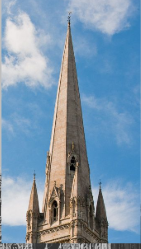
Gables
It is the portion of the front or side of a building enclosed by or masking the end of a pitched roof.
FINIALS
It is the decorative upper termination of a pinnacle, gable end, buttress, canopy, or spire